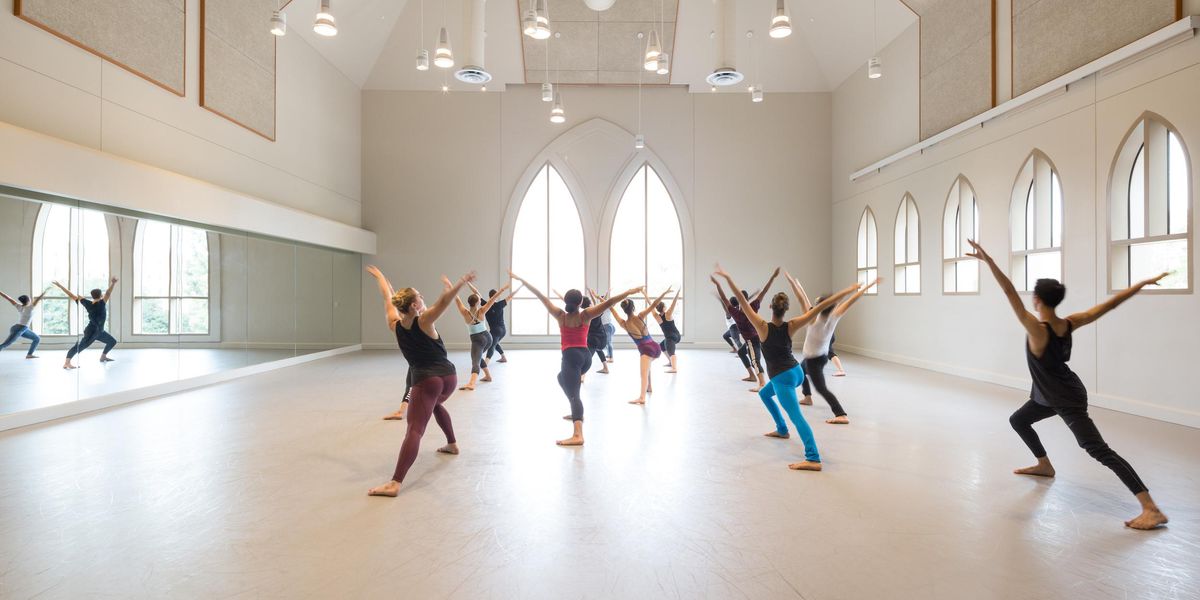2013 Summer Study Guide: Digging Deep
At The Performing Arts Project, the work lies in learning to be yourself.
Grady Bowman teaches a tap class at The Performing Arts Project. Photo:
Vesic.com, Courtesy TPAP.
If you’re interested in musical theater, you probably spend hours in dance classes, from tap to ballet, along with lessons in voice, acting, and even audition skills. You toil tirelessly on technique, but when it comes to working in a sustained way on artistry—learning to transform exercises in the studio into magic onstage—training opportunities are harder to come by.
A new summer program of The Performing Arts Project is helping to fill that gap, allowing young performers—dancers, singers, actors, and combinations of all three—to make the critical connection between practice and art. Set on the idyllic campus of Wake Forest University in North Carolina, the three-week intensive brings together students ages 16 to 24 with faculty culled from Broadway’s best. Courses like Monologue Study and Jazz Dance fulfill technical needs, while more unusual offerings like Gaga expand the program past standard musical theater fare, placing a greater emphasis on individual expression and preparing students for life as a professional.
“Our philosophy is process over product,” says Jonathan Bernstein, artistic director of the program and a longtime New York City director and writer. “I wanted to create a safe atmosphere where students could experience the exhilaration of being themselves. I asked my favorite people from the New York industry—like Christopher Gatelli, Susan Misner, Grady Bowman, Tyler Hanes, Kelly King, and Nikole Vallins—to help me in my mission to not only work with students on becoming richer artists, but world citizens who know how to collaborate and listen.”
This approach rang true for Nikole Vallins, a well-known New York City producer, coach, and casting director. (Among the many shows she’s cast are A Chorus Line, Finian’s Rainbow, and Gypsy.) “Often performers come to an audition and try to fit what they think the team wants, but nowadays there’s no mold,” explains Vallins, who taught two courses—Business of the Business and Audition Technique—at TPAP. Along with the other TPAP instructors, she was hoping to instill a different kind of mindset in dancers: “Come in with a sense of yourself as an artist and what you specifically can offer, with confidence and ease. All you can do is be yourself and show who you are. That’s scary, to be asked to do something other than exact choreo-graphy or behaving a certain way. But it’s never going to get easier once you’re in New York. This is the best way to get over your fears, with people who have been behind the table and will catch you when you fall.”
TPAP’s summer intensive is intimate; it aims for no more than 100 students. Mornings are usually spent in technique classes, which can vary from ballet to “viewpoints” (the avant-garde acting technique developed by Mary Overlie and Anne Bogart). For Grady Bowman, choreographer and veteran Broadway performer, the breadth of classes adds complexity to traditional training. “Susan Misner’s Intention of Movement class is a perfect example of artistry imbued in technique classes,” he says. “The class is focused on giving every movement acting intention, which is crucial in all performance, especially auditions. You may be doing a glissade, but in musical theater there’s a reason. If the choreographer hasn’t given you one, you need to find your own to make it more than just a step.”
On alternate days, students delve deeper into their “focus area”—dance, acting, or voice—which they select before the program begins. Days and nights can be spent in rehearsal, but unlike other programs where the sessions are geared toward a final showcase—and where faculty teach well-known Broadway repertoire—TPAP’s serve as experimental breeding grounds.
“We teach by example,” says Bernstein. “Faculty can try things in these rehearsals they’ve been thinking about, teach pieces that are brand-new, and sometimes throw up their hands and say, ‘I don’t know what comes next.’ By osmosis, the students sense we are taking risks ourselves and feel comfortable doing so, too. You can’t fake that.” Community members and parents are invited to a closing weekend festival, where they can attend open classes, panel discussions, and site-specific shows.
Throughout the intensive, Bernstein made a point of emphasizing interaction between faculty and students. This could mean sharing tables in the cafeteria or space in the studio; teachers are encouraged to take other classes when not busy teaching their own. Bowman says this fosters the kind of collaborative spirit that students will need in a professional environment. “Everyone has a different process,” he says. “You have to be adaptable to that and to the people around you, while staying grounded in who you are as an artist.”
Bernstein says he’s thrilled with the outcome of the inaugural year. “The students ran with the philosophy artfully and elegantly—more than I could have hoped,” he says. “They understood the idea of no judgment and prized bravery and adventurousness in each other. Ninety-five people from all over the hemisphere created an ensemble that protected and learned from each other in a staggeringly short amount of time. Beautiful artistry emerged and we hope to do that each summer.”
Lauren Kay is a dancer and writer in New York City.




